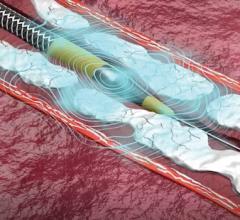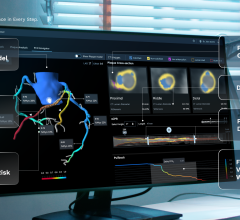
The Medis Quantitative Flow Ratio (QFR) is a novel, non-invasive, angiography-based physiologic FFR-like assessment of the presence and extent of coronary artery disease.
December 16, 2020 – Acist Medical Systems Inc. announced a formal distribution partnership with Medis Medical Imaging to co-market in North America. This partnership is focused on Quantitative Flow Ratio (QFR), a novel, non-invasive, angiography-based physiologic assessment of the presence and extent of coronary artery disease.
Headquartered in Leiden, Netherlands, Medis has been developing innovative post-processing software for the quantification of cardiovascular images for over 30 years, with QFR as their latest product. The QFR system is am image derived fractional flow reserve (FFR) technology that can measure the amount of blood flow through a coronary lesion or vessel segment to determine if a stent is required or if the patient can be treated medically.
Watch a quick VIDEO example of the QFR technology.
“This strategic collaboration expands our portfolio and enables Acist to better support the evolving needs of our customer. This partnership solidifies Acist’s position as the preferred physiology partner of choice with the ability to offer both invasive and non-invasive approaches to support the clinical utility that physiology provides,” said Brad Fox, president and CEO, Acist Medical Systems Inc.
Medis’ QFR is a proprietary solution delivering image-based functional assessment of coronary obstructions from standard coronary angiograms. The novel QFR approach applies advanced mathematical modeling to accurately and effectively measure the physiologic and anatomical extent of a patient’s coronary artery disease. QFR also improves the patient experience with fast procedure times, no invasive pressure wire, and no required adenosine administration.
According to Morton Kern M.D., chief of cardiology and interventional cardiologist at the VA Long Beach Healthcare System, California, “QFR represents a significant advance for assessment of coronary artery disease in the cath lab. Like other angiographically derived FFR, QFR will let the angiographer see the physiologic impact of the stenoses within a vessel of interest and make an informed decision on whether to stent or not without the need of a pressure wire or adenosine. While still in early clinical use, QFR and other angio-derived FFR systems will become a dominant method in the coming years by improving the patient experience and simplifying PCI decision-making.”
The QFR analysis is performed during the interventional procedure and can streamline workflow in the cath lab while driving economic value. Unlike traditional invasive assessments, including FFR and iFR, the QFR analysis output is co-registered with the angiogram and automatically identifies and prioritizes any functionally significant coronary obstructions. QFR provides the healthcare professional with more extensive and quantitative physiologic imaging results to support the patient’s diagnosis and better inform the patient’s treatment.
“Collaborating with Acist expands our global reach with a proven commercial partner in the USA, helping Medis bring value-based, clinically proven imaging innovation to more clinicians and patients. Introducing QFR in the USA is in line with the aspiration of Medis to establish QFR as the world’s leading technology in angio-based functional assessments,” stated Hans Brons, CEO of Medis.
Watch a quick VIDEO example of the QFR technology.
For more information: medisimaging.com, www.acist.com
Related FFR-Angio Content:
Image-based FFR May Replace Pressure Wires and Adenosine
7 Trends in Interventional Lab Angiography Systems
New Technology Directions in Fractional Flow Reserve (FFR)


 November 14, 2025
November 14, 2025 









